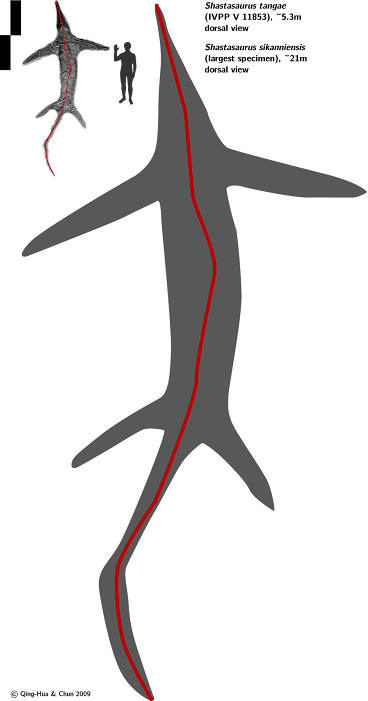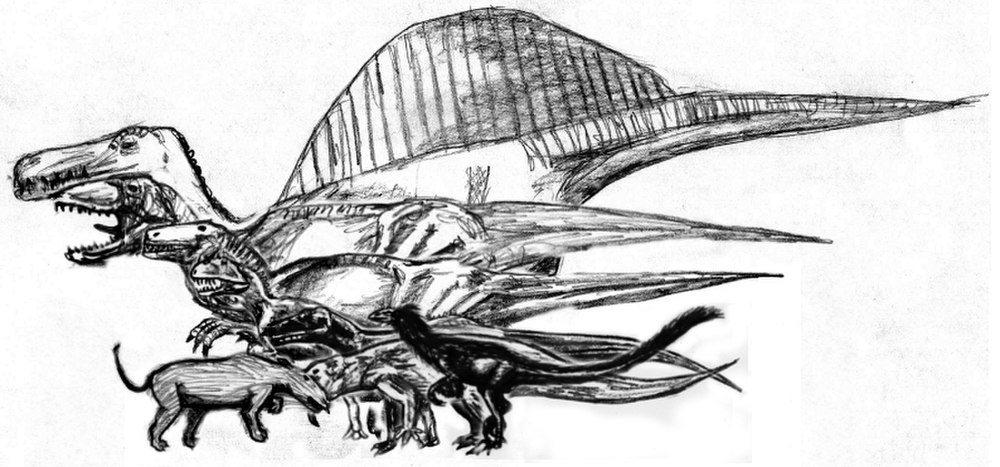guategojira
Junior Member
  Now I become death, the destroyer of worlds!
Now I become death, the destroyer of worlds!
Posts: 160 
|
Post by guategojira on Apr 4, 2014 6:49:33 GMT 5
Smilodon Populator - Smilodon Fatalis - Bengal Tiger - Average Joe  Greatest prehistoric cats;  I don’t know who made this comparison (Smilodon-tiger) but it is exaggerated and inaccurate. The body dimensions of the Smilodon fatalis are no larger than an African lion, although it weighed much more. I made this comparison, again using the excellent draws of Mauricio Antón, which base his draws in the real fossils:  As we can see, there is practically no difference between the Smilodon fatalis and the largest tiger subspecies (Amur-Bengal, which are of the same size), at least in linear dimensions. Now, about the images of Roma Uchytel, I advice you to not use it anymore, as I have discovered that his comparisons are not only inaccurate, but also he is not reliable, check this topic that I created: animalbattle.yuku.com/topic/47/Is-Roman-Uchytel-reliable#.Uz4K0lcXK8wEvery comparison most have backup data, we can’t make comparisons with random figures, like he have done.  Ps. The shoulder height of 95 cm correspond with an average Amur tiger, the tallest male recorded by the STP was of 106 cm. Ps. The shoulder height of 95 cm correspond with an average Amur tiger, the tallest male recorded by the STP was of 106 cm. |
|
|
|
Post by Grey on Apr 17, 2014 2:40:43 GMT 5
 The author said me he'll correct the genus as Otodus or Carcharocles. The otodontid is at ~18 m. The physeteroid is at ~14 m. |
|
|
|
Post by elosha11 on Apr 18, 2014 10:42:56 GMT 5
^Nice pic. It would be interesting to see this Livyatan depiction at the holotype's maximum proposed length, 17.5 meters. Also don't know why the author didn't draw the teeth in the upper jaw of either animal.
|
|
|
|
Post by Grey on Apr 18, 2014 15:58:29 GMT 5
I guess that the upper teeth at least in megalodon were not necesserily visible while not attacking. I'm these times discussing about megalodon and Livyatan with this artist and a related student in biology developping his thesis work at the Vertebrate Paleontology Department of the Lima Museum who was involved in the Livyatan project in 2010.
|
|
|
|
Post by elosha11 on Apr 21, 2014 4:24:05 GMT 5
Good point.
|
|
|
|
Post by Life on Apr 21, 2014 12:29:08 GMT 5
GreyNice share; Megalodon depiction is EXCELLENT. However, Livyatan depiction does not seems to be accurate. This is a reliable Livyatan depiction, IMO: 
|
|
|
|
Post by Grey on Apr 21, 2014 16:49:56 GMT 5
GreyNice share; Megalodon depiction is EXCELLENT. However, Livyatan depiction does not seems to be accurate. This is a reliable Livyatan depiction, IMO:  Why do you think it's not accurate ? Because of the speculative dorsal fin ? Except for that the proportions of the skull seemed fine to me, but one can complain about the body length and favor a longer postcranial structure. I know that model and I agree that's probably one of the best depiction of Livyatan, from a rigorous scientific source. But a scale size with that one would be useful for that we compare it with the Megalodon. |
|
|
|
Post by Grey on Jun 22, 2014 23:32:14 GMT 5
Balaenoptera hubachi from the Pliocene of Chile.  Balaenoptera balaenopsis from the Pliocene of Belgium.  Parotodus benedeni from Pliocene. Could possibly reach 10 % larger.  |
|
|
|
Post by theropod on Jul 9, 2014 21:36:52 GMT 5
 Reference→ Reference→I stumbled across this while organising my paper collection. Since there is what seems like a reasonably perpendicular photograph of a skeleton of Shastasaurus, I thought I’d try making a size comparison. In confirmation of that, the measured axial lenght based on the scalebar is consistent with the "more than 5.2m" given by the describers. The large silhouette is scaled to the 21m usually given for S. sikanniensis. |
|
|
|
Post by Grey on Jul 18, 2014 14:44:55 GMT 5
Physeter macrocephalus and the Miocene Physeterula dubusi:  Pliocene Orcinus citoniensis :  Aulophyseter morricei :  One of the many diverse forms of sperm whales from the Miocene, Aulophyseter was a fish & squid eater and unlikely modern sperm whales it had teeth in both lower and upper jaws, was also a lot smaller than modern sperm whales. Microberardius, a Middle Miocene pocket relative of modern giant bottlenose whales :  |
|
|
|
Post by Grey on Jul 22, 2014 3:39:24 GMT 5
 Macrokentriodon morani was one of the largest kentriodontids along with Hadrodelphis (between 4-5m long), these delphinoids thrived during the Miocene but became extinct as the Pliocene epoch began. Reference: S. D. Dawson. 1996. A new kentriodontid dolphin (Cetacea; Delphinoidea) from the middle Miocene Choptank Formation, Maryland.Journal of Vertebrate Paleontology 16(1):135-140 |
|
blaze
Paleo-artist   
Posts: 766
|
Post by blaze on Jul 23, 2014 7:08:04 GMT 5
Revised C. megalodon size chart.  |
|
|
|
Post by Grey on Jul 27, 2014 10:38:44 GMT 5
That scale comparison is probably the very best I've seen of that species and helps me to envision C. megalodon without a pug-nose.
The final model used by B.W.K will be seen itself in the section of the book "The Geology and Fauna of Calvert Cliffs".
|
|
|
|
Post by theropod on Aug 8, 2014 3:18:19 GMT 5
I’ve been overhauling some of the inaccurate comparison from when I was a kid:  Representative giant land predators: Spinosaurus (black), Saurophaganax (green), Andrewsarchus (orange), Megalania (light green), Allosaurus (yellow) and Kelenken (dark green). Kelenken based on "A New Phorusrhacid (Aves: Cariamae) from the Middle Miocene of Patagonia, Argentina", Varanus priscus silhouette from "Dragon’s Paradise Lost: Palaeobiogeography, Evolution and Extinction of the Largest-Ever Terrestrial Lizards (Varanidae)",, Sarcosuchus silhouette based on image from Phylopic by Smokeybjb ( source→), Andrewsarcus inspired by and based on blaze’s one.  Comparison of the three proposed genera in Allosauridae |
|
Deleted
Deleted Member
Posts: 0
|
Post by Deleted on Sept 6, 2014 11:08:16 GMT 5
An Allosaurus vs Camarasaurus size comparison from Scott Hartman that I found somewhere on the web  |
|